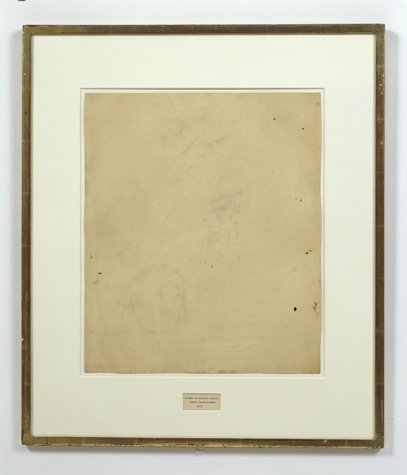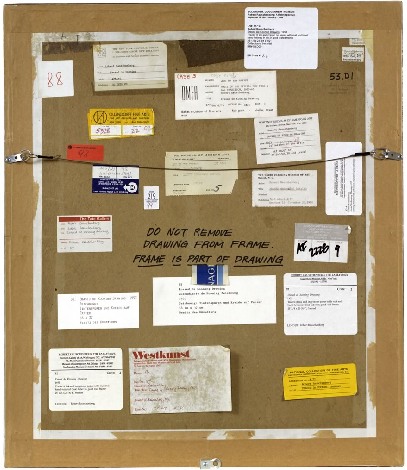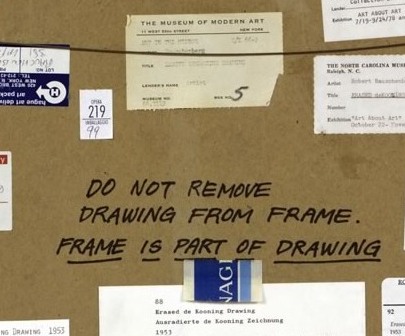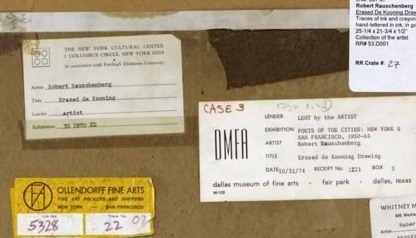How do we know what we know, and when?

For instance, we know that Erased de Kooning Drawing (1953) is one of Robert Rauschenberg's most important, influential works. It's the kind of commonly accepted history that lands a piece in the Final Four of Tyler Green's Art Madness poll to determine America's Greatest Post-War Artwork.
And we know the story of it, how Bob took a bottle of liquor with him to Bill's studio to ask for a drawing to erase. And how Bill, at first reluctant, twice-validated the sacrifice by giving away "a drawing he'd miss" and which would be "hard" for Bob to erase. And then Bob signed it and framed it and sparked an art world scandal with it which hasn't really abated. We know this because Bob and then his curator and critic advocates repeat the story so frequently. [Vincent Katz has a nice telling of it in Tate Magazine in Autumn 2006.]
But this weekend, I suddenly had cause to wonder just how all this went down, and when, really, did this revolution start? Because it's not as clear or as obvious as I had always assumed.
That's Erased de Kooning Drawing up there, precisely matted and framed. That's how I saw it for the first time in Walter Hopps' "Rauschenberg In The Early 1950s" show at the Menil 20 years ago, and then again in John Cage's "Rolywholyover" a couple of years after that. [Or am I conflating the two Guggenheim SoHo versions of those shows?]
At the time, it was still in the artist's own collection. In 1998, SFMOMA acquired it along with a group of other Rauschenberg works. [Calvin Tomkins wrote in the New Yorker in 2005 that MoMA was offered the works first and turned them down.] Its official description: "drawing | traces of ink and crayon on paper, mat, label, and gilded frame." It's not just a drawing, not just an erased drawing, it's an object assembled.
SFMOMA has a nice little, c.2000 interactive that includes the back of the piece:

"DO NOT REMOVE
DRAWING FROM FRAME
FRAME IS PART OF DRAWING"

LOVE THAT. I could geek out staring at the backs of artworks all day. Did Bob himself write that? It looks like it.
The early line on Erased de Kooning was either "neo-dada," which was a standard critical reaction to Rauschenberg in the 50s, or AbEx patricide. But it has since evolved far beyond these bad boy, enfant terrible readings, to be considered a precursor of huge swaths of contemporary art.
In his 2009 book, Random Order: Robert Rauschenberg and the Neo-Avant-Garde, Branden Joseph discussed Erased de Kooning Drawing as one of the touchstones of conceptual art and appropriation art, alongside Marcel Duchamp's mustache-on-the-Mona-Lisa, L.H.O.O.Q:
Whether by defacement or effacement, the two works' devaluation of the appropriated representation (an essential factor in the process of allegorization) is equally effective. Rauschenberg's subsequent mounting of the erased sheet of paper within a gold frame, together with the addition of a carefully hand-lettered label with a new authorial attribution, title, and date ("Erased de Kooning drawing / Robert Rauschenberg / 1953"), simultaneously doubles the visual text with a new signification and calls attention away from the (now depleted) visual aspect of the work and toward the conventional and institutional devices of the work's "framing."...For Rauschenberg's Erased de Kooning Drawing essentially reenacted the reception of his White Paintings: the initial evacuation of expressive or representational meaning in favor of transitional, temporal forces subsequently gave way to a process in which meaning was reattributed to the work from the outside.Indeed it was. As the White Paintings were to the reflections and shadows in the room, so Erased de Kooning Drawing was to passing theories of art.
In 1976 Bernice Rose put "the famous Erased de Kooning drawing" along side Jasper Johns' Diver at the foundation of The Modern's major survey, "Drawing Now." Reviewing the show for the New Yorker, Harold Rosenberg dismissively labeled Pop, Minimalism and Conceptualism, the work that followed Rauschenberg's and Johns's "parodies of Action painting," as the new "Academy of the Erased de Kooning."
Later that year, the drawing was in Walter Hopps' Rauschenberg Retrospective at the Smithsonian, which traveled back, in 1977, to MoMA. Where it prompted Grace Glueck to open her NY Times story with a rhetorical question--"Wasn't it only a couple of years ago that Robert Rauschenberg erased a drawing by Willem de Kooning?"
Yes, only a couple, give or take twenty four. Maybe it just took that long to get it. We had to wait for Conceptualism to be invented before anyone could recognize Erased de Kooning was its foundation.
In the September 1982 issue of Artforum, none other than Benjamin Buchloh discussed Erased de Kooning Drawing's historical importance in a sprawling 14-page essay titled, "Allegorical Procedures: Appropriation and Montage in Contemporary Art":
At the climax of the Abstract Expressionist idiom and its reign in the art world this may have been perceived as a sublimated patricidal assault by the new generations most advanced artists, but it now appears to have been one of the first examples of allegorization in post-New York School art. It can be recognized as such in its procedures of appropriation, the depletion of the confiscated image, the superimposition or doubling of a visual text by a second text, and the shift of attention and reading to the framing device. Rauschenberg's appropriation confronts two paradigms of drawing: that of de Kooning's denotative lines, and that of the indexical functions of the erasure. Production procedures (gesture), expression, and sign (representation) seem to have become materially and semantically congruent. Where perceptual data are withheld or removed from the traditional surface of display, the gesture of erasure shifts the focus of attention to the appropriated historical constrict on the one hand, and to the devices of framing and presentation, on the other.Whew. But.
Back up. Because here is Buchloh's account of the gesture, and of the "device of framing and presentation":
After the careful execution of the erasure, which left vestiges of pencil and the imprint of the drawn lines visible as clues of visual recognizability, the drawing was framed in a gold frame. An engraved metal label attached to the frame identified the drawing as a work by Robert Rauschenberg entitled[Emphasis added because, WTF engraved metal label?] When did it have a metal label?and dated 1953.
There wasn't one in 1991 when I saw it. And there wasn't one in 1976, when Walter Hopps wrote this catalogue entry: "He [Rauschenberg] then hand-lettered the title, date of the work, and his name on a label and placed the drawing in a gold-leaf frame bought specifically for it." [Oddly, the only source Hopps cites is an Interview Magazine Q&A, dated May 1976, just as the catalogue was being produced.]
There is no way that the hand-drawn label in the middle of the mat of Erased de Kooning Drawing could be mistaken for a metal label on a frame. At least if you had seen the work in person. Or had discussed it with anyone who had. So the implication, then, is that in 1982, Benjamin Buchloh had not actually seen Erased de Kooning Drawing, or that he'd misremembered it or misread a photo of it, and neither he nor anyone at the magazine of record noticed the error. Which does make some sense if Erased de Kooning is a conceptual work in the mode of Joseph Kosuth, not an art object, per se but an "idea of an art work [whose] formal components weren't important." [Of course, Kosuth said that in 1965, more than a decade after Rauschenberg apparently already demonstrated it.]

But there are some problems here. Judging by all the registrars' labels and notes on the back, it seems impossible that someone like Benjamin Buchloh would not have seen Erased de Kooning Drawing in the 30 years since its creation. But looking more closely, I can't find any exhibitions dating before 1973. That's when Susan Ginsburg's show, "3D Into 2D: Drawing For Sculpture," opened at the New York Cultural Center. [Ginsburg was, among many other things, a board member of Change, Inc., an artist emergency assistance foundation Rauschenberg started in 1970.]
Was Erased de Kooning Drawing shown in the 60s? Or the 50s, for that matter? Where? How? What was the reaction? Because the triumphant Conceptualist historicization of the work seems to have obscured--if not actually erased--its early history.












